Although there were many things which made a July day at Steigerwald National Wildlife Refuge one of my most successful outings of the year, my favorite highlights came from a single species of bird: The American Bittern. I spent a full day birding the refuge, and saw several other species as well, but none dominated my day like the bitterns; it left me with so much to share, I’ve split up my recap of this visit so I can dedicate the third and final one to these small herons. If you missed them, be sure to check out my previous posts about my day at Steigerwald (Part 1 & Part 2).
I’ve been birding as an active hobby, list keeping and all, for not quite three years now. Pictures of the American Bittern – a supposedly common bird for the area which I had somehow never managed to see despite living in the region my entire life – captured my interest early, but they remained elusive. I frequently would hear from other birders on the trail about one they had seen only minutes before in a place I hadn’t quite reached in time. (I had similar struggles with the Green Heron, but had finally tracked that species down in December 2014.) Steigerwald National Wildlife Refuge even has a picture of one as the cover of their brochure, but that was as close as I’d come to finding a bittern. So when I set out in July, my constant hope to find just one to add to my list was there but not high.
It’s not uncommon to find a female Northern Harrier cruising over the marsh and fields you immediately encounter as you set off on the trail at Steigerwald. These large brown birds of prey will often remain on the ground amid the grasses when they are successful in capturing a meal. So when I saw a flash of brown wings out in the sea of green, my first thought was that she’d caught something, and it had been before I came through; hoping she’d take wing with her prize soon since there was movement, I took up a spot at the side of the trail and watched where I’d seen the wings, waiting. And waiting.
It can be very trying at times, being a birder. Or, possibly worse, being the non-birder walking companion of a birder. Sometimes, birding means standing still and doing next to nothing for long periods while you wait – and not always with the results you hope for. Several minutes went by, and there were no more wing sightings. Marking the place by a stand of reeds among the grass and a slight rise of the ground, I tried moving down the trail for a different vantage point. Then back. Scanning with my binoculars for a better view. There! Something…but, that was not a wing. Can you spot the bird in the photo below?
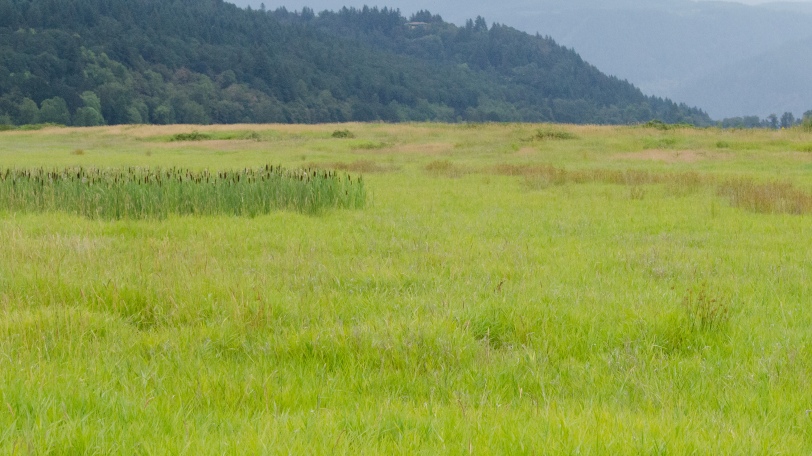
That was a head! It was almost impossible to pick out among the tall vegetation, but there it was – the long and narrow head of an American Bittern, peering up and out. I almost whooped out loud! Can you see the bird now?
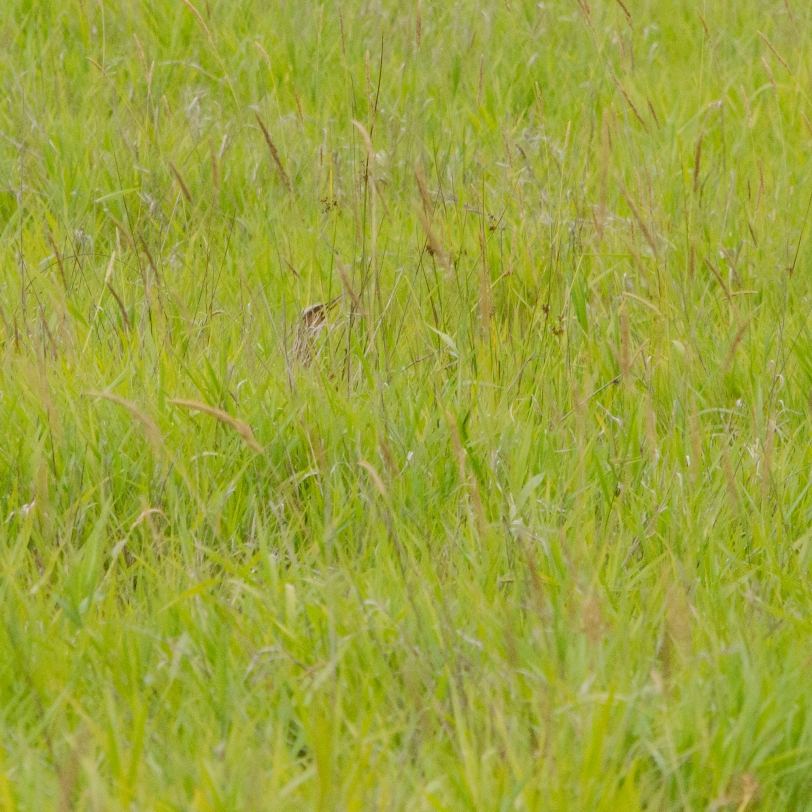
American Bitterns are incredibly well camouflaged, colored in feathers of brown, white, and tan; vertical stripes run down their bodies which blend into the flora of their preferred marshes and wetlands, especially when they stand with their necks stretched upwards. I tracked the narrow head perched on that elongated neck as it slowly moved through the grass, disappearing sometimes only to appear further along its course a few moments later. It was comparable to whale watching, where you see the animal surface only briefly and try to predict its trajectory and where you’ll see it spout next. My prediction was that the bird was moving towards a creek which runs through the refuge and so I moved quietly along the trail in that direction. Sure enough, that’s where the bird emerged – for about two seconds before it spooked and high-tailed it back into the grass. I got one clear shot of a bittern’s back end before it disappeared.
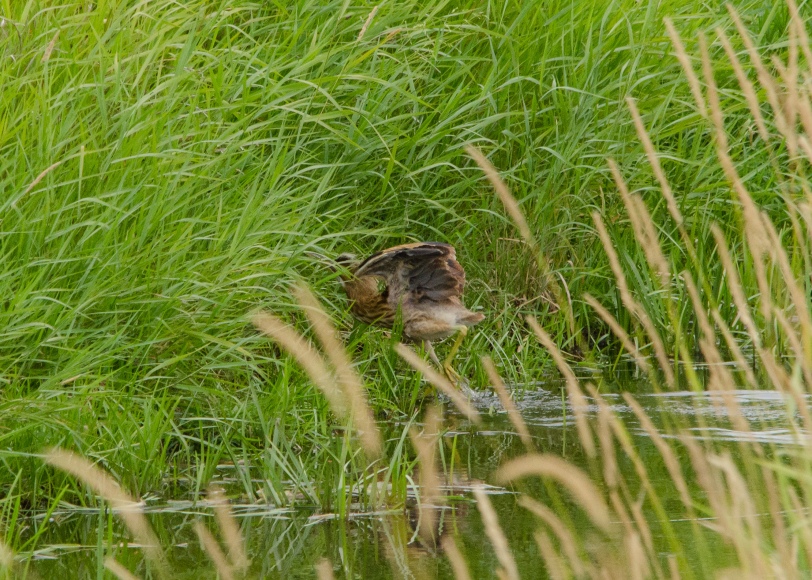
With an audible rustling of feathers, the bird took flight away from the trail; it flew in a pose similar to its much larger cousin, the Great Blue Heron, with its neck tucked back and yellow-green legs stretched behind it. It was not nearly as graceful, however, and soon was back in the grass.
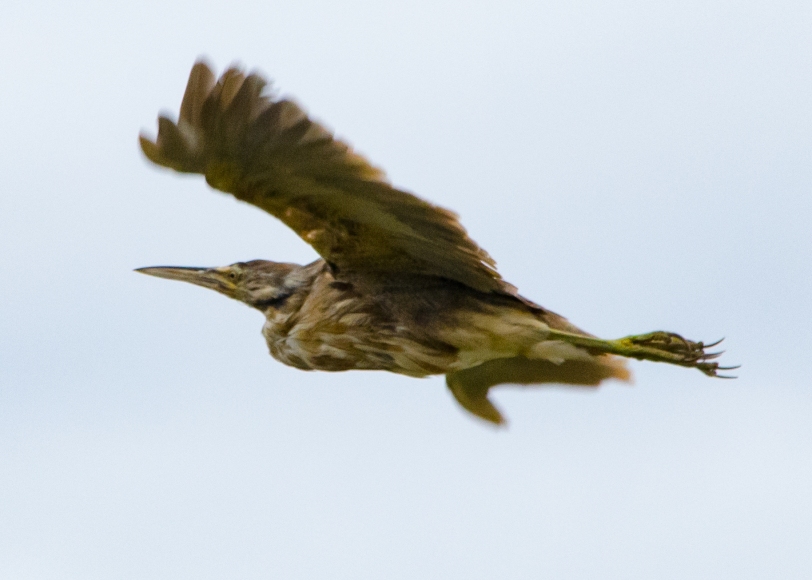
Looking back at the creek, I realized that the American Bittern I’d seen take flight had not been alone. Slow and cautious, a second bird was creeping out at the edge of the water. Finally, I got a good long look at the bird I’d been stalking for nearly 45 minutes. It did not stay long, and unlike its counterpart it simply melted back into the grass. Satisfied, I walked down the trail with a silly grin on my face. (The same big, silly grin I wear every time I find a new bird or have an awesome encounter. It never gets old!)
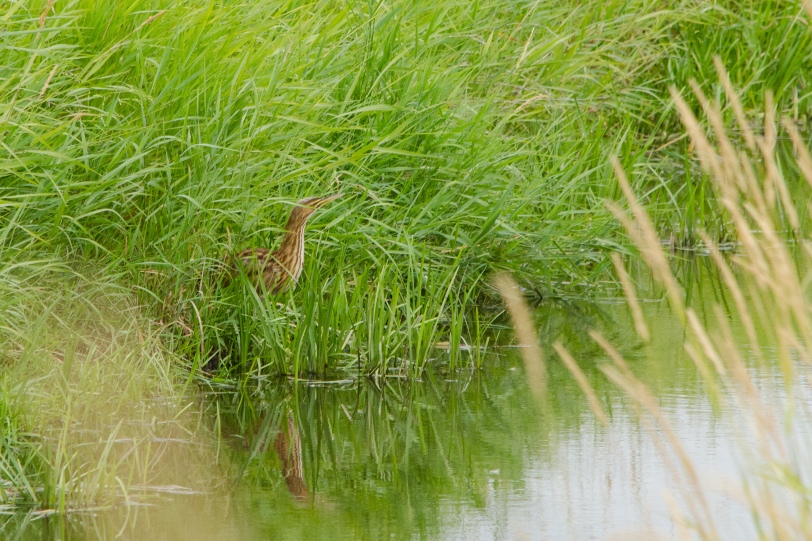
Coming to where the trail goes along the north side of Redtail Lake, I encountered another American Bittern. This one was out in the open, although moving rather quickly. It crossed through shallow water covered in lily pads, pausing at the edge of the water briefly before vanishing into the vegetation lining the bank. Pleased with a third hard (for me) to find bird, my birding venture continued.
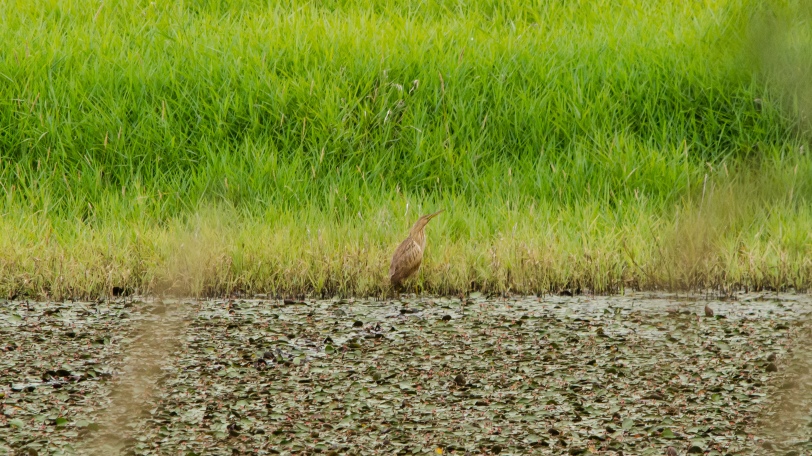
In the afternoon, as I was nearing the end of my day, I decided that since it had been so productive I would give the stretch of trail between Gibbons Creek and Redtail Lake a second walk-through. Sometimes, I make good decisions. Standing at the north end of the wooden bridge crossing the creek, looking out in both directions to see what caught my eye, I heard a loud rustling from directly underneath me. The creek was rather low, and the gully it runs through full of grasses and other plants. Whatever it was moving around, it sounded large; I expected maybe a nutria or a turtle (they are surprisingly loud when on land, if you’ve never encountered this). Stepping carefully so as not to startle whatever was beneath me, I moved to the railing of the bridge and readied my camera. As I pointed the lens down, I was happily surprised to find an American Bittern staring right back up at me.
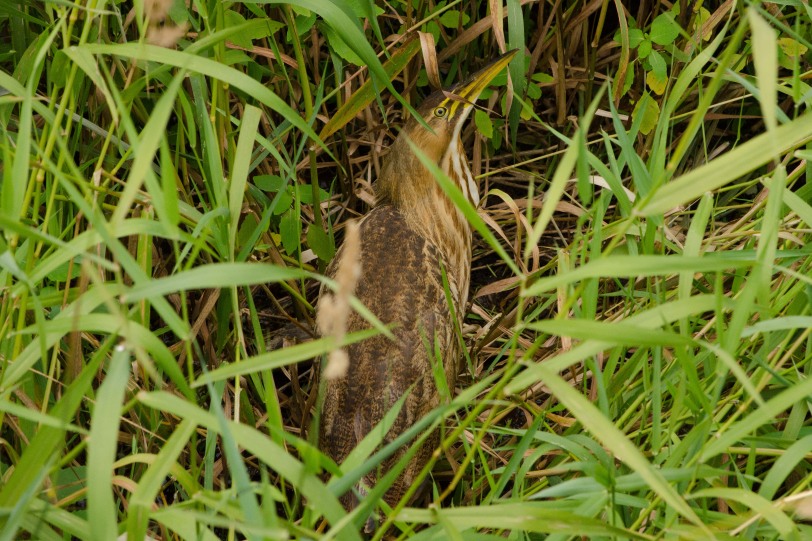
He did not seem bothered in the least to find my camera pointed at him (or her), staying for a few seconds, head turning to get a better look. Seemingly deciding I was not a threat, the bird continued its slow progression along the creek. A few feet on, blending once more into its surroundings, the bird stopped and began its raucous calling. It was not the ‘booming’ which is common (and sounds sort of like a plunger in water), but almost more of a barking. It carried quiet well, and several other human visitors who were on the trail nearby stopped while it went on for a good minute. And then the bird was silent, and had disappeared.
Giddy from that amazing encounter, I went down to the next bridge on the trail and found another up-close American Bittern! This was incredible! This one strongly reminded me of the skeksis, the bird-like villains from the Jim Henson movie, The Dark Crystal. Initially the bird flew away from me (surprise, I hadn’t seen this well-disguised bird immediately) but it landed quite close and crept back out to hunt where I could watch from the bridge. Although I compared the bird to characters which are quite old and decrepit, my guess is that its appearance was actually due to youth; it still had some juvenile fluff and the adult feathers were still coming in.
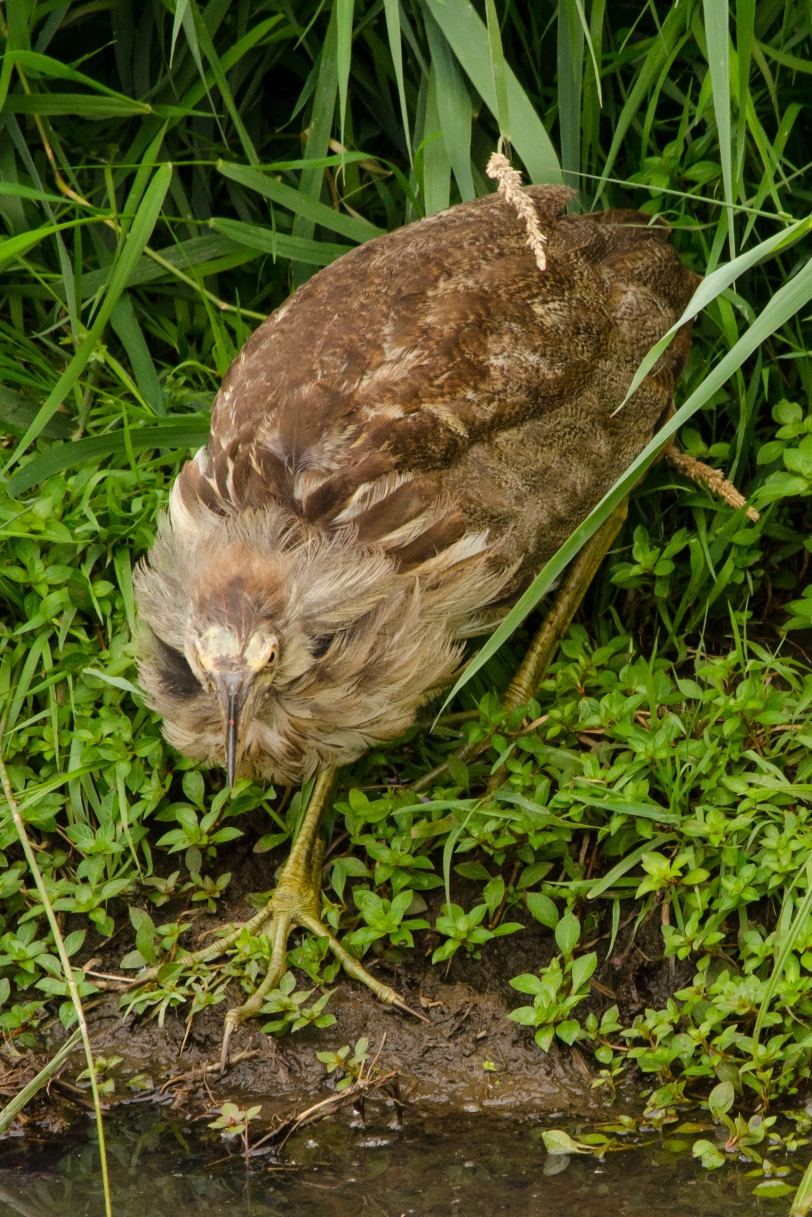
The bittern was fairly in the open here, giving me a fantastic view of its full form. The yellow-green legs ended in long toes, giving it the weight displacement it needed to not sink into the mud. Each toe ended in a low claw, for traction and grip as it moved across potentially slick and slimy surfaces. As with all birds, the skin of its legs was scale-like, and it added to the caricature-like appearance of this particular specimen.
Just in case I hadn’t mentioned it before now, I was feeling pretty successful and excited about my day at this point. Logic said I’d best call it before I pressed my birding luck too far; I turned to go back across the bridge and found just one more bittern for my day. Out amid the marsh, this bird looked just as surprised as I was when we noticed each other; it went rigid with its neck straight up – which, when you are taller than everything around you, doesn’t actually help you blend in at all, this bird seemed to realize. A moment later it began moving again, walking away from me for a distance with slow, carefully placed steps.
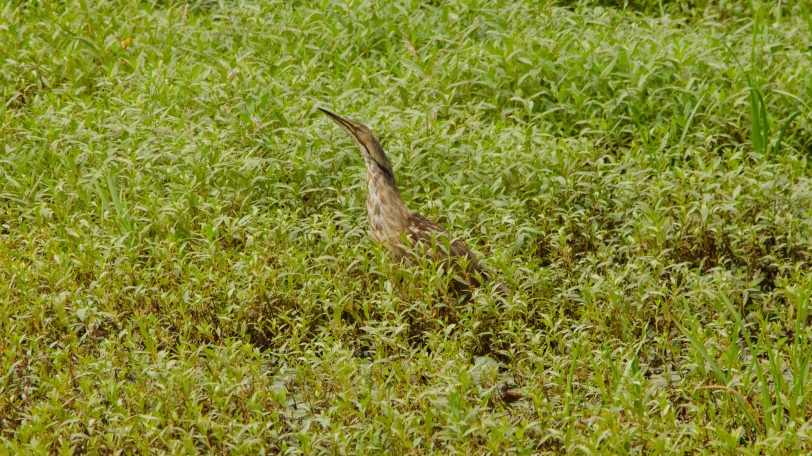
I stood where I was, not wanting to bother the bird further, but apparently this was not enough. It took to the air and flew further out into the refuge, leaving me behind. It was definitely time to wrap up this trip!
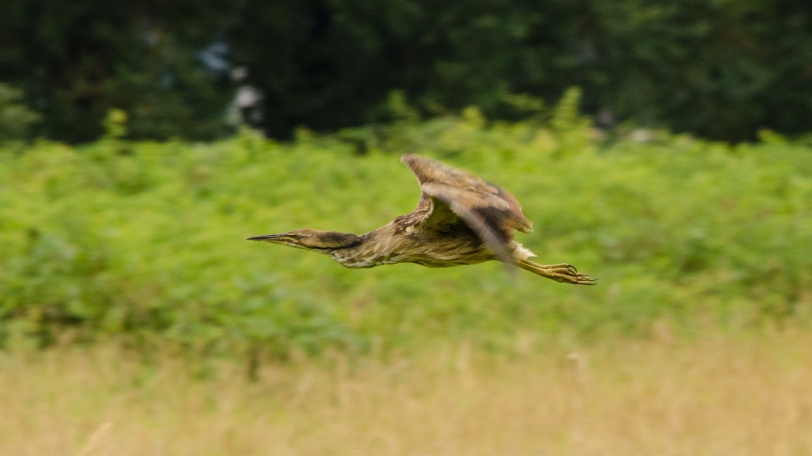
I had a crazy-fun time running into the American Bitterns all day long out at Steigerwald. Overall, my day in the field saw me able to identify a total of 30 species including both Year and Life List additions. To find a little more information about Steigerwald National Wildlife Refuge and other places for bird watching, including addresses and websites, check out my Birding Locations page.
Be sure to visit my Flickr site for many more images from my trip to Steigerwald National Wildlife Refuge this day, as well as some of my other photographs.
Comments are always welcome!

Have you ever hear the Am. Bittern? They are quite fun to listen to!! ‘Thunder Pumper’ indeed; I put a sound byte on my post. (http://wp.me/p28k6D-1Dn)
LikeLike
That WAS an amazing encounter. Great shots all of them. I can’t believe you captured him so well in flight.
LikeLike
Thank you! I was really pleased with how cooperative they (and my camera) were being on this trip. Couldn’t ask for better!
LikeLike
It would be nice if all outings produced such results, hm? Happy birding!
LikeLiked by 1 person
I have heard them – The first time I listened to a recording, I realized I’d been assuming that sound was bullfrogs when out on my hikes. Now I know better! It’s such a weird but cool sound.
LikeLiked by 1 person